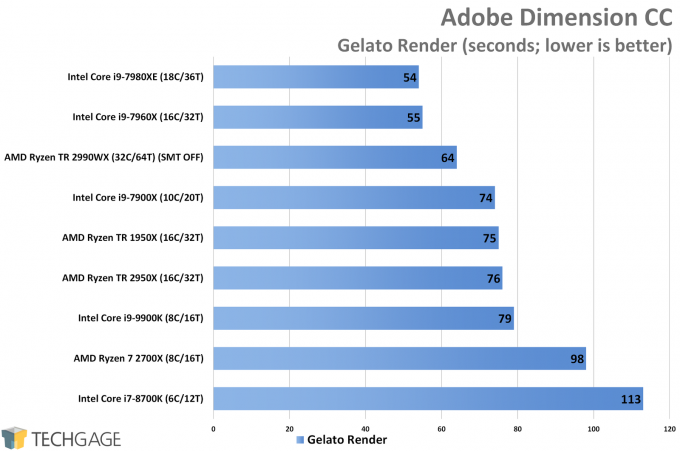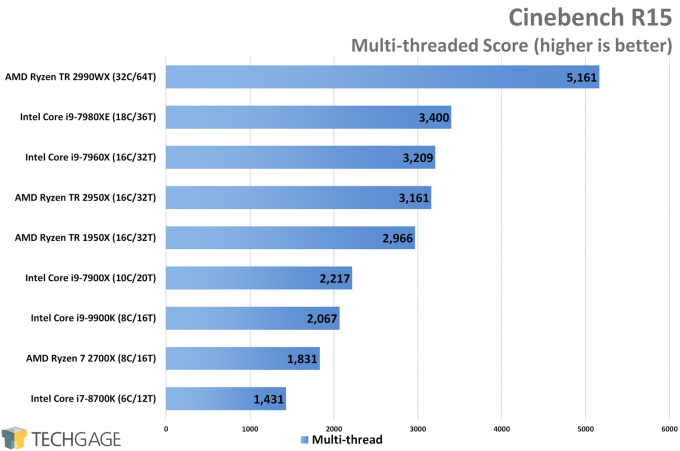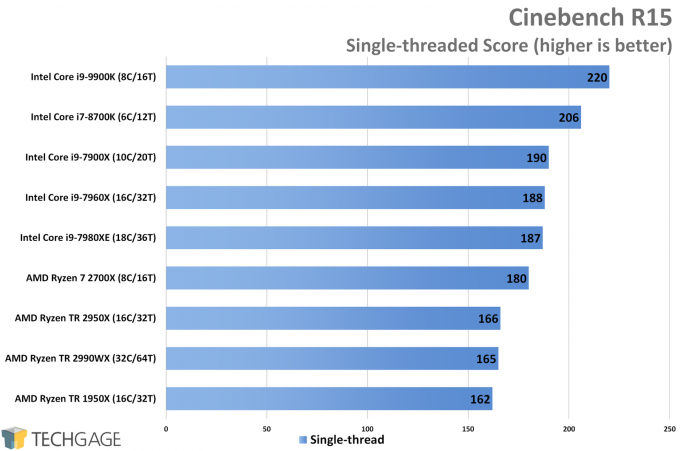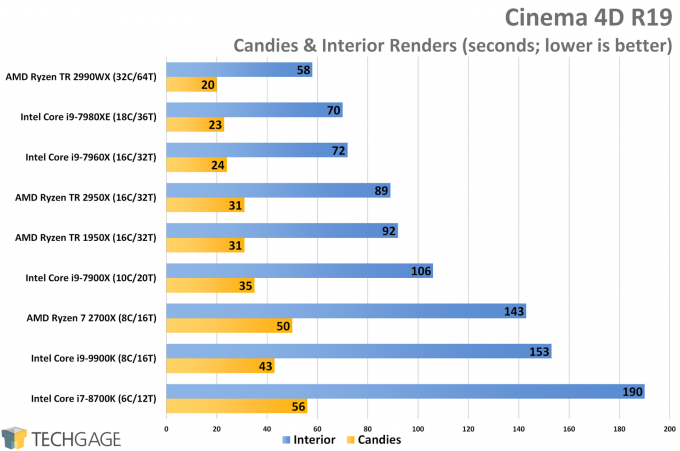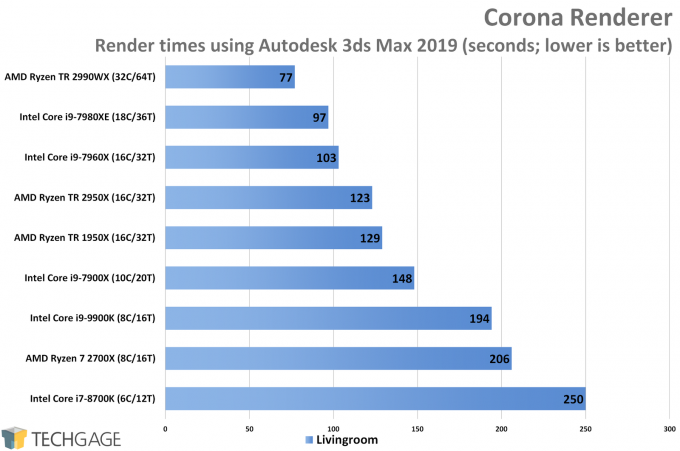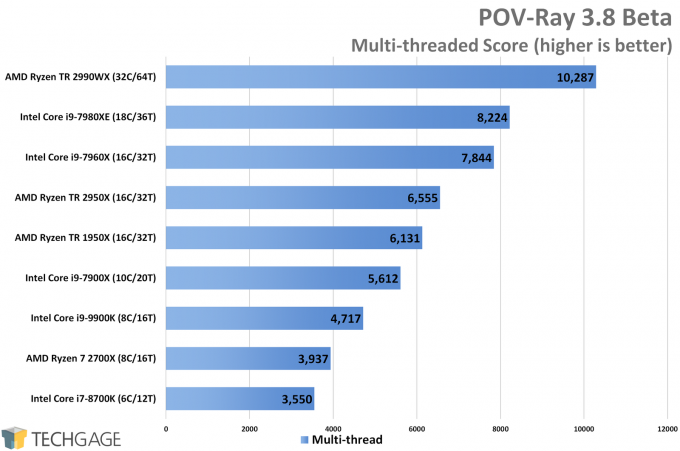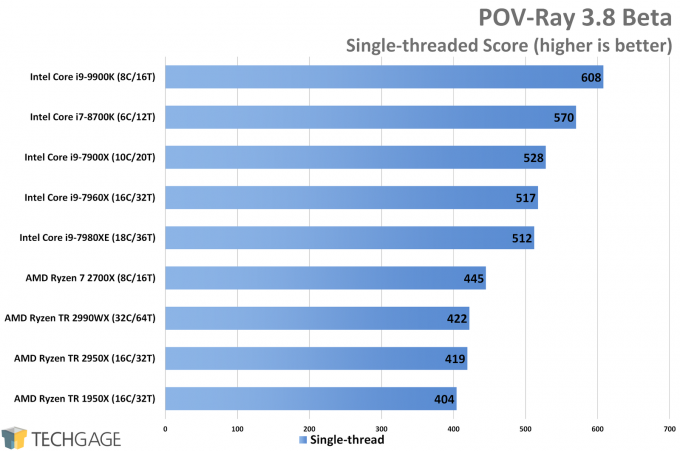- Qualcomm Launches Snapdragon 4 Gen 2 Mobile Platform
- AMD Launches Ryzen PRO 7000 Series Mobile & Desktop Platform
- Intel Launches Sleek Single-Slot Arc Pro A60 Workstation Graphics Card
- NVIDIA Announces Latest Ada Lovelace Additions: GeForce RTX 4060 Ti & RTX 4060
- Maxon Redshift With AMD Radeon GPU Rendering Support Now Available
A Look At Intel Core i9-9900K Workstation & Gaming Performance

There’s a lot to like about Intel’s Core i9-9900K that goes beyond adding 33% more cores over last year’s i7-8700K. The 9900K can peak at 5GHz, and barely throttles back when all eight cores are engaged. Add to that the introduction of solder TIM, a chip like the 9900K has been a long time coming, so let’s dive in.
Page 5 – Rendering: Adobe Dimension, Cinebench, Cinema 4D, Corona, POV-Ray
We hope you’re not sick of rendering, because there’s a lot more of it on this page. On the previous page, many big-name renderers were tackled, but on this one, others are being gazed at, along with some synthetic tests that will allow you to test your own PC against ours.
Adobe Dimension
Adobe’s Dimension is a newer application, only a little older than a year. Despite its young age, it’s experienced a number of builds that have continued to iterate on performance and stability. Recently, Dimension CC 2.0 came out, but this performance here is based on the older 1.1.1 version.
You’ll notice that the 2990WX was tested with SMT off for this one, and that’s because the project won’t open on the platform with SMT left on. That’s something that doesn’t change with the new 2.0 version, and is likely a bug that will never get resolved without moving to a different project. We definitely have that planned at some point in the future.
This is one test where the 9900K really managed to separate itself from the 2700X, and gain even better when compared to the 8700K. Dimension doesn’t seem to love AMD too much, given the 16-cores perform a pinch worse than Intel’s 10 core, so pure strength on the AMD side is needed to impress us here.
No surprises here: Intel dominates an Adobe test. Next!
Cinema 4D & Cinebench
We continue with everyone’s favorite standalone benchmark: Cinebench. Like the standalone V-Ray benchmark, the overall usefulness of Cinebench in today’s landscape is questionable, since five major Cinema 4D versions have been released since Cinebench R15. That said, while the GPU test in Cinebench is certifiably useless at this point in time, the CPU-based renderer hasn’t likely changed all too much between R15 and R20 – but even so, it represents a definite “best case” for rendering.
That all said, the 9900K soars past the 8700K to hit nearly 2070 Cinebench points, edging out AMD’s equally eight-core 2700X. As for the 2990WX, it’s experienced some hitches on its journey to this point, but it sure does enjoy the view from up top here.
Multi-threaded performance is only part of the equation: what about single-threaded?
With the 8700K, Intel impressed us all with leading Cinebench single-thread scores, and it’s once again impressed with its new 9900K. This is one of the rare tests that completely separates Intel from AMD, since its IPC and clock speeds are top-rate, and very hard to beat. Naturally, the highest-clocked of the AMD parts beat the bigger core models, oddly putting the 8-core AMD Ryzen close to the 18-core Intel.
Synthetic testing is fine for the most part, but a performance evaluation wouldn’t be complete without some real-world tests. Does the real Cinema 4D match the performance of the standalone benchmark? That apparently depends.
The 9900K easily beat out AMD’s 2700X in Cinebench, but the battle is fiercer with the real Cinema 4D. Here, the 2700X actually beats Intel’s 9900K in the interior scene render, with the roles reversed for the candies render.
One thing Cinema 4D and Cinebench can agree on is that the more cores you have at your disposal, the happier you’re going to be when rendering with MAXON’s design tool. That’s probably part of the reason AMD has been cooperating with MAXON quite a bit this past year, partly fueled by the fact that the company’s ProRender plugin is now available for C4D.
Corona Renderer
Are you tired of seeing renderers that scale really well yet? Hopefully not, because Corona once again shows us what a decked-out processor is capable of. Like KeyShot, Corona is unique in that it completely ignores the GPU for rendering, so quite simply, the more powerful your CPU, the better your rendering performance is going to be. That remains true all the way up to the top with the Threadripper 2990WX.
This is another test where AMD’s Ryzen 7 2700X doesn’t fall too far behind the 9900K. Why that’s notable is that AMD offers some very good performance-to-cost ratios. To get better than the 9900K in this lineup, you’ll be splurging on an enthusiast platform, either with AMD’s entry-level Threadrippers, or Intel’s Core-X – the latter of which starts at $1,000 for the 10-core model.
POV-Ray
Our Cinebench scores from earlier highlight a reason why AMD is so keen on promoting its chips with it. There, the 32-core 2990WX outperformed the 18-core i9-7980XE by 50%. In POV-Ray, a classic ray tracer, that gain gets whittled down to 25%. That’s still noteworthy, but of course doesn’t quite scale like we’d expect a move from 18- to 32-cores to.
POV-Ray also disagrees a bit in the 9900K vs. 8700K battle. In Cinebench, the gain was 44%, whereas here, it’s “only” 33%. Considering the fact that the 9900K has 33% more cores than the 8700K, a 33% gain in performance seems a lot more likely than 44%.
What about single-thread performance?
Single-thread performance is where POV-Ray agrees with Cinebench, as the 9900K performs about the same 7% better than the 8700K. Ultimately, POV-Ray performance only matters so much, but it’s a good gauge to see how each chip will handle single-threaded operations, which aside from your heaviest workloads will dominate your computing.
Support our efforts! With ad revenue at an all-time low for written websites, we're relying more than ever on reader support to help us continue putting so much effort into this type of content. You can support us by becoming a Patron, or by using our Amazon shopping affiliate links listed through our articles. Thanks for your support!




